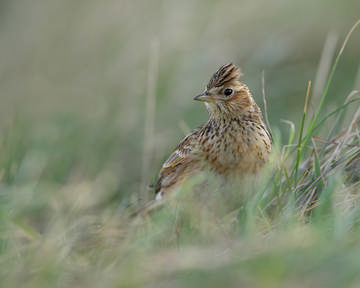
Skylark © Richard Steel
Many Skylarks remain on their territories in the lowlands all year round. Others leave their breeding areas and join flocks, moving to lower ground or southwards. The winter map shows a similar distribution to that for the breeding season, although the species is everywhere more thinly distributed. Detailed studies have shown that Skylark winter density halves for every 140 m increase in altitude (Donald 2004) and most birds quit the eastern hills: Skylarks were recorded in 30 tetrads above 200 m in the breeding season, but only 10 of them in winter, and six of these ten were February records with the observers noting song, so probably most of these records were breeding birds returning early to their territories. 269 tetrads were occupied in both seasons, 211 tetrads had birds in the breeding season but not in winter and 34 tetrads were occupied in winter but not during the breeding season.
As well as the altitudinal move, and some partial migration, Skylarks shift habitats in winter. Grazed grassland, never their favourite habitat in the breeding season, is used even less in winter, and their preferred winter habitats are coastal marshes and weedy cereal stubbles. They are always wary of predators from the field edges, so Skylarks feed only in large fields, avoiding anywhere less than 2.5 ha and selecting fields larger than 7.5 ha, and they favour areas with low hedges and no large trees (Gillings & Fuller 2001). They roost at night on the ground, often where they have been feeding.
Of the winter habitat codes, 85% were farmland and 10% semi-natural grassland and marsh. Observers in 61 tetrads recorded birds in stubble, more than any other species, with amplifying comments indicating 7 instances of wheat stubble and four of maize. Most birds were found in singles or pairs, probably the resident birds, and the median flock size was only four. 72 flocks were counted with 10-30 birds, and there were just 33 submitted counts of more than 30 birds in one flock. Seven flocks of 100 or more birds were reported during this Atlas, from widely scattered parts of the county. The largest by far, 1000 birds, was on the Dee saltmarsh in SJ27U, with others on the Dee in SJ27S and SJ28Q, and the Mersey saltmarsh in SJ47D. Three-figure gatherings on farmland were at Risley (SJ69Q and SJ69R), with flocks noted on stubble near Little Leigh (SJ67D) and Blakenhall (SJ74I). Extrapolating from the mean density, there are probably just over 5,000 Skylarks in the county in an average winter.
Outside the breeding season, Skylarks switch to a mainly vegetarian diet, taking a great variety of leaves, seeds and cereal grain (Green 1978). They gain most of their energy from grain and seeds, also taking any arthropods whenever they can find them, but – perhaps because they cannot find sufficient seeds – they often eat copious quantities of leaves; these are of low nutritional value, however, and their digestive system is not adapted to breaking down cellulose. Much of the cause of their population decline is attributable to winter food supplies. On arable land, the shift to autumn sowing of cereals hit Skylarks badly, in two ways: the loss of stubble reduces overwinter survival, then, for much of the breeding season, the crop is too tall for them to nest in. High levels of insecticide and herbicide use on farmland have also reduced weed seed and invertebrate food resources.
The general description of the species’ status has probably not changed for a century. Coward wrote that ‘in winter it is absent from the bleak moorlands, but frequents the open country of the lowlands in flocks. Especially during hard weather when the inland districts are almost forsaken, great numbers of larks frequent the Dee marshes.’ Boyd noted that ‘throughout winter even in the coldest weather many remain in the stubble and old potato ground’. Probably the main aspect of their behaviour that has changed is their hard weather movements, for which Skylark used to be a classic species. Coward and Bell wrote about memorable movements of large flocks, and the county bird reports in the 1980s detailed several movements out of the county, or to the Dee, in spells of freezing weather up to December 1989. The only significant episode since then was in January/ February 1997 when up to 5,000 were found on the Dee in cold weather. No such event has been recorded in the last decade of mild winters.
Sponsored by Chester RSPB Group

